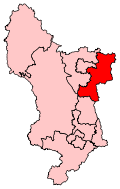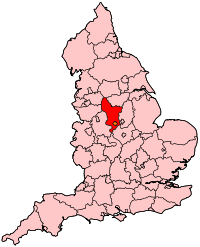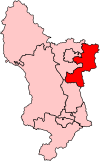Bolsover (UK Parliament constituency)
Bolsover (/ˈbɒlsˌoʊvər/, /ˈbɒlzˌoʊvər/ and commonly /boʊzər/) is a constituency in Derbyshire, represented in the House of Commons of the UK Parliament by Mark Fletcher, a member of the Conservative Party. The constituency was created in 1950, and is centred on the town of Bolsover.
| Bolsover | |
|---|---|
| County constituency for the House of Commons | |
 Boundary of Bolsover in Derbyshire for the 2010 general election | |
 Location of Derbyshire within England | |
| County | Derbyshire |
| Population | 94,473 (2011 census)[1] |
| Electorate | 72,162 (December 2010)[2] |
| Major settlements | Bolsover, Shirebrook |
| Current constituency | |
| Created | 1950 |
| Member of Parliament | Mark Fletcher (Conservative) |
| Number of members | One |
| Created from | Clay Cross and North East Derbyshire |
Between 1970 and 2019, the constituency was represented by Labour's Dennis Skinner, who by 2019 was the oldest member of the House of Commons and the second longest-serving. At the constituency's inception it was one of the safest Labour seats in the country, but over the following half century Skinner's vote share dropped from 77% to only 36%, with the result that he lost the seat to the Conservatives by a margin of 11%.
History
Before the Reform Act 1832, relatively wealthy people (forty-shilling freeholders) of the whole county could attend elections when there was an opposition candidate. From 1868 until 1885 the area formed part of the East Derbyshire constituency, redrawn out of the North Derbyshire constituency formed in 1832. The Bolsover constituency was created in 1950 from parts of the constituencies of North East Derbyshire, formed in 1885, and Clay Cross, formed in 1918.
Boundaries

1950–1983: The Urban District of Bolsover, and the Rural Districts of Blackwell and Clowne.
1983–2010: The District of Bolsover, and the District of North East Derbyshire wards of Morton, Pilsley, Shirland, and Sutton.
2010–present: The District of Bolsover, and the District of North East Derbyshire wards of Holmewood and Heath, Pilsley and Morton, Shirland, and Sutton.
Constituency profile
The seat includes many former mining communities. Before 2019 it was a Labour Party stronghold, although the then MP Dennis Skinner's share of the popular vote dropped to 50% in the 2010 election from a high of 77.5% (see below). Its economy faced struggles after the last closures in the early 1990s of the coal pits upon which the area thrived for many years. From the 1970s, the pits faced increased international competition on price and required a government subsidy. This was achieved in Eastern Europe, albeit on lower wages, which ceased under Margaret Thatcher. Bolsover's tourism industry has emerged in recent years, including accommodation and tours involving Bolsover Castle, owned by English Heritage, and Hardwick Hall, home of Bess of Hardwick.
Skinner, who held the seat from 1970 until 2019, is a former miner whose fast wit and often abrasive manner in the House of Commons led to him being dubbed "The Beast of Bolsover". At the 2017 general election, Skinner's majority was cut to little more than 5,000, the first time the Labour majority in the seat had ever been lower than 10,000. He failed to be re-elected in 2019, missing out on becoming the Father of the House after the retirement of Kenneth Clarke.[3] However, Skinner had earlier said that he would refuse the title anyway.[4]
Members of Parliament
| Election | Member[5] | Party | |
|---|---|---|---|
| 1950 | Harold Neal | Labour | |
| 1970 | Dennis Skinner | ||
| 2019 | Mark Fletcher | Conservative | |
Elections
Elections in the 2010s
| Party | Candidate | Votes | % | ± | |
|---|---|---|---|---|---|
| Conservative | Mark Fletcher | 21,791 | 47.4 | ||
| Labour | Dennis Skinner | 16,492 | 35.9 | ||
| Brexit Party | Kevin Harper | 4,151 | 9.0 | N/A | |
| Liberal Democrats | David Hancock | 1,759 | 3.8 | ||
| Green | David Kesteven | 758 | 1.7 | N/A | |
| Independent | Ross Walker | 517 | 1.1 | N/A | |
| Independent | Natalie Hoy | 470 | 1.0 | N/A | |
| Majority | 5,299 | 11.5 | N/A | ||
| Turnout | 45,938 | 61.1 | |||
| Conservative gain from Labour | Swing | ||||
| Party | Candidate | Votes | % | ± | |
|---|---|---|---|---|---|
| Labour | Dennis Skinner | 24,153 | 51.9 | ||
| Conservative | Helen Harrison | 18,865 | 40.5 | ||
| UKIP | Philip Rose | 2,129 | 4.6 | ||
| Liberal Democrats | Ross Shipman | 1,372 | 2.9 | ||
| Majority | 5,288 | 11.4 | |||
| Turnout | 46,519 | 63.3 | |||
| Labour hold | Swing | ||||
| Party | Candidate | Votes | % | ± | |
|---|---|---|---|---|---|
| Labour | Dennis Skinner | 22,542 | 51.2 | +1.2 | |
| Conservative | Peter Bedford | 10,764 | 24.5 | -0.1 | |
| UKIP | Ray Calladine | 9,228 | 21.0 | +17.1 | |
| Liberal Democrats | David Lomax | 1,464 | 3.3 | -12.2 | |
| Majority | 11,778 | 26.8 | +1.4 | ||
| Turnout | 43,998 | 61.1 | +0.6 | ||
| Labour hold | Swing | +0.7 | |||
| Party | Candidate | Votes | % | ± | |
|---|---|---|---|---|---|
| Labour | Dennis Skinner | 21,994 | 50.0 | N/A | |
| Conservative | Lee Rowley | 10,812 | 24.6 | N/A | |
| Liberal Democrats | Denise Hawksworth | 6,821 | 15.5 | N/A | |
| BNP | Martin Radford | 2,640 | 6.0 | N/A | |
| UKIP | Ray Calladine | 1,721 | 3.9 | N/A | |
| Majority | 11,182 | 25.4 | N/A | ||
| Turnout | 43,988 | 60.5 | N/A | ||
| Labour win (new boundaries) | |||||
Elections in the 2000s
| Party | Candidate | Votes | % | ± | |
|---|---|---|---|---|---|
| Labour | Dennis Skinner | 25,217 | 65.2 | −3.4 | |
| Liberal Democrats | Denise Hawksworth | 6,780 | 17.5 | +5.6 | |
| Conservative | Hasan Imam | 6,702 | 17.3 | −2.2 | |
| Majority | 18,437 | 47.6 | -1.5 | ||
| Turnout | 38,699 | 57.3 | +0.8 | ||
| Labour hold | Swing | −4.5 | |||
| Party | Candidate | Votes | % | ± | |
|---|---|---|---|---|---|
| Labour | Dennis Skinner | 26,249 | 68.6 | −5.4 | |
| Conservative | Simon Massey | 7,472 | 19.5 | +2.8 | |
| Liberal Democrats | Marie Bradley | 4,550 | 11.9 | +2.6 | |
| Majority | 18,777 | 49.1 | -7.8 | ||
| Turnout | 38,271 | 56.5 | −14.7 | ||
| Labour hold | Swing | ||||
Elections in the 1990s
| Party | Candidate | Votes | % | ± | |
|---|---|---|---|---|---|
| Labour | Dennis Skinner | 35,073 | 74.0 | +9.5 | |
| Conservative | Richard Harwood | 7,924 | 16.7 | −8.6 | |
| Liberal Democrats | Ian Cox | 4,417 | 9.3 | −0.9 | |
| Majority | 27,149 | 57.3 | +18.1 | ||
| Turnout | 47,414 | 71.3 | -7.8 | ||
| Labour hold | Swing | +9.1 | |||
| Party | Candidate | Votes | % | ± | |
|---|---|---|---|---|---|
| Labour | Dennis Skinner | 33,978 | 64.5 | +8.3 | |
| Conservative | Timothy D.R. James | 13,323 | 25.3 | −3.0 | |
| Liberal Democrats | Susan P. Barber | 5,368 | 10.2 | −5.3 | |
| Majority | 20,655 | 39.2 | +11.3 | ||
| Turnout | 52,669 | 79.1 | +1.8 | ||
| Labour hold | Swing | +5.7 | |||
Elections in the 1980s
| Party | Candidate | Votes | % | ± | |
|---|---|---|---|---|---|
| Labour | Dennis Skinner | 28,453 | 56.2 | -0.1 | |
| Conservative | Michael Lingens | 14,333 | 28.31 | +1.4 | |
| SDP | Mark Fowler | 7,836 | 15.48 | -1.3 | |
| Majority | 14,120 | 27.89 | -1.5 | ||
| Turnout | 50,622 | 77.34 | |||
| Labour hold | Swing | ||||
| Party | Candidate | Votes | % | ± | |
|---|---|---|---|---|---|
| Labour | Dennis Skinner | 26,514 | 56.3 | N/A | |
| Conservative | S. Roberts | 12,666 | 26.9 | N/A | |
| SDP | S. Reddish | 7,886 | 16.8 | N/A | |
| Majority | 13,848 | 29.4 | N/A | ||
| Turnout | 72.67 | ||||
| Labour win (new boundaries) | |||||
Elections in the 1970s
| Party | Candidate | Votes | % | ± | |
|---|---|---|---|---|---|
| Labour | Dennis Skinner | 27,495 | 66.58 | ||
| Conservative | Anthony Favell | 10,116 | 24.49 | ||
| Liberal | James Ian Frost | 3,688 | 8.93 | ||
| Majority | 17,379 | 42.08 | |||
| Turnout | 78.31 | ||||
| Labour hold | Swing | ||||
| Party | Candidate | Votes | % | ± | |
|---|---|---|---|---|---|
| Labour | Dennis Skinner | 27,275 | 70.55 | ||
| Conservative | C.L. Sternberg | 6,209 | 16.06 | ||
| Liberal | M. Taylor | 5,176 | 13.39 | ||
| Majority | 21,066 | 54.49 | |||
| Turnout | 74.52 | ||||
| Labour hold | Swing | ||||
| Party | Candidate | Votes | % | ± | |
|---|---|---|---|---|---|
| Labour | Dennis Skinner | 30,787 | 76.47 | -1.03 | |
| Conservative | A.R. Dix | 9,474 | 23.53 | +1.03 | |
| Majority | 21,313 | 52.94 | -2.06 | ||
| Turnout | 78.38 | ||||
| Labour hold | Swing | ||||
| Party | Candidate | Votes | % | ± | |
|---|---|---|---|---|---|
| Labour | Dennis Skinner | 28,830 | 77.50 | ||
| Conservative | Ivor J Humphrey | 8,371 | 22.50 | ||
| Majority | 20,459 | 55.00 | |||
| Turnout | 70.76 | ||||
| Labour hold | Swing | ||||
Elections in the 1960s
| Party | Candidate | Votes | % | ± | |
|---|---|---|---|---|---|
| Labour | Harold Neal | 30,114 | 81.55 | ||
| Conservative | Peter C Coleman | 6,815 | 18.45 | ||
| Majority | 23,299 | 63.09 | |||
| Turnout | 74.62 | ||||
| Labour hold | Swing | ||||
| Party | Candidate | Votes | % | ± | |
|---|---|---|---|---|---|
| Labour | Harold Neal | 31,234 | 79.34 | ||
| Conservative | Patrick Cormack | 8,131 | 20.66 | ||
| Majority | 23,103 | 58.69 | |||
| Turnout | 78.89 | ||||
| Labour hold | Swing | ||||
Elections in the 1950s
| Party | Candidate | Votes | % | ± | |
|---|---|---|---|---|---|
| Labour | Harold Neal | 32,536 | 78.2 | ||
| Conservative | Robin Marlar | 9,076 | 21.8 | ||
| Majority | 23,460 | 56.4 | |||
| Turnout | 82.5 | ||||
| Labour hold | Swing | ||||
| Party | Candidate | Votes | % | ± | |
|---|---|---|---|---|---|
| Labour | Harold Neal | 30,074 | 78.87 | ||
| Conservative | Brian RO Bell | 8,055 | 21.13 | ||
| Majority | 22,019 | 57.75 | |||
| Turnout | 77.57 | ||||
| Labour hold | Swing | ||||
| Party | Candidate | Votes | % | ± | |
|---|---|---|---|---|---|
| Labour | Harold Neal | 33,661 | 79.89 | ||
| Conservative | John Cordeaux | 8,472 | 20.11 | ||
| Majority | 25,189 | 59.78 | |||
| Turnout | 85.36 | ||||
| Labour hold | Swing | ||||
| Party | Candidate | Votes | % | ± | |
|---|---|---|---|---|---|
| Labour | Harold Neal | 34,017 | 80.6 | ||
| Conservative | John Cordeaux | 8,184 | 19.4 | ||
| Majority | 25,833 | 61.2 | |||
| Turnout | 86.2 | ||||
| Labour win (new seat) | |||||
Notes and references
- Notes
- References
- "Bolsover: Usual Resident Population, 2011". Neighbourhood Statistics. Office for National Statistics. Archived from the original on 4 March 2016. Retrieved 31 January 2015.
- "Electorate Figures – Boundary Commission for England". 2011 Electorate Figures. Boundary Commission for England. 4 March 2011. Archived from the original on 6 November 2010. Retrieved 13 March 2011.
- "Labour legend Dennis Skinner facing shock general election defeat, says new polling". November 5, 2019.
- Moss, Stephen (May 2, 2015). "Labour's Dennis Skinner at 83: 'Father of the House? You must be joking'" – via www.theguardian.com.
- Leigh Rayment's Historical List of MPs – Constituencies beginning with "B" (part 4)
- "Election Nominees 2019" (PDF). Bolsover District Council. Retrieved 15 November 2019.
- "Election Data 2015". Electoral Calculus. Archived from the original on 17 October 2015. Retrieved 17 October 2015.
- "Election Data 2010". Electoral Calculus. Archived from the original on 26 July 2013. Retrieved 17 October 2015.
- "Election Data 2005". Electoral Calculus. Archived from the original on 15 October 2011. Retrieved 18 October 2015.
- "Election Data 2001". Electoral Calculus. Archived from the original on 15 October 2011. Retrieved 18 October 2015.
- "Election Data 1997". Electoral Calculus. Archived from the original on 15 October 2011. Retrieved 18 October 2015.
- "Politics Resources". Election 1997. Politics Resources. 1 May 1997. Archived from the original on 14 June 2012. Retrieved 2011-01-10.
- C. Rallings & M. Thrasher, The Media Guide to the New Parliamentary Constituencies, p.36 (Plymouth: LGC Elections Centre, 1995)
- The 1997 election result is calculated relative to the notional, not the actual, 1992 result.
- "Election Data 1992". Electoral Calculus. Archived from the original on 15 October 2011. Retrieved 18 October 2015.
- "Politics Resources". Election 1992. Politics Resources. 9 April 1992. Archived from the original on 24 July 2011. Retrieved 2010-12-06.
- "Election Data 1987". Electoral Calculus. Archived from the original on 15 October 2011. Retrieved 18 October 2015.
- "Election Data 1983". Electoral Calculus. Archived from the original on 15 October 2011. Retrieved 18 October 2015.
- "1970 election".
- "1966 election".
- "1964 election".
- "1959 election".
- "1955 election".
- "1951 election".
- "1950 election".
External links
- nomis Constituency Profile for Bolsover — presenting data from the ONS annual population survey and other official statistics.